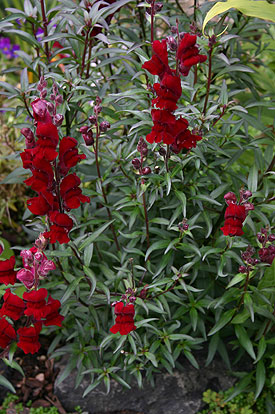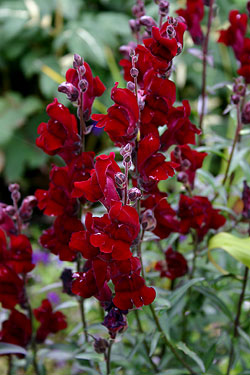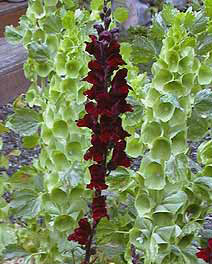Antirrhinum majus 'Black Prince'
SNAPDRAGON
Family: Scrophulariaceae
Pronounced: an-tih-RI-num MAY-jus
Quick Jumps
Growing Guide
Rainy Side Notes
GROWING GUIDE

Origin:
Garden.
Plant Group:
Short-lived perennial, usually grown as an annual.
Hardiness:
Sunset zones: A1, A3; 1-24.
USDA zones: down to 5 when grown as an annual; winter hardy in zones 7-10.
Mature size:
Height: 18 inches (45 cm).
Flowering period:
Summer until frost.
Flowering attributes:
Racemes of deep crimson flowers.
Leaf attributes:
Lance-shaped, bronze leaves.
Light:
Full sun.
Soil:
Moist, humus rich, well-drained soil.
Feeding:
Use a complete organic fertilizer when planting. If the plants winter over, side dress with fertilizer and compost in spring.
Propagation Methods:
Sow seed January to March at 68-86°F (20-30°C).
Pruning Methods:
Deadhead flowers to prolong blooming.
Pests and Diseases:
Rust and botrytis may be problematic. Aphids, spider mites and caterpillars may be troublesome. None have caused problems in my garden.
Rainy Side Notes


I grew A. 'Black Prince' in front of Bells of Ireland (Moluccella laevis) this year, which really made the deep crimson snapdragon flowers and dark leaves "pop" in front of the light green flowers of Bells of Ireland. As a cut flower, it is outstanding. If wintered over it will begin to flower in May; in my garden, the plants continued flowering through November.
For the vase, cut flowers when about 1/3 of the flowers are open or approximately eight flowers. Flowers persist 5-8 days in water.
All parts of the plant are poisonous; do not ingest! Snapdragons are great bee plants.
Debbie Teashon
Photographed in author's garden.

Gardening for the Homebrewer: Grow and Process Plants for Making Beer, Wine, Gruit, Cider, Perry, and More
By co-authors Debbie Teashon (Rainy Side Gardeners) and Wendy Tweton
Copyright Notice | Home | Search | Annuals

